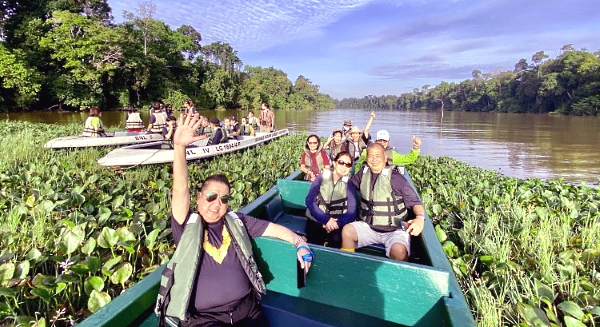
By Lee San
Six in the morning, the group members were already aboard the boats cruising swiftly along the Kinabatangan River in Sandakan to explore the many secrets the area has to offer. The noise of motor wakened the morning sun and the quiet water. The sky was decorated with fluffy white clouds, rare hornbills and small groups of egrets impatiently spreading their wings to take to the sky as if to frolic with us. Despite the fact the river flow was swift due to the ample rainfall, we could see bubbles on the water surface, probably from the fishes and shrimps equally excited about our visit.
Normally during this travel season when most of us would otherwise venture abroad, such a marvelous natural landscape right here in Malaysia is something quite inconceivable, so unpretentiously natural and captivating. We would not have imagined that an Amazon-like forest actually exists within our own shores. I couldn't help but yelled out loudly to the great river and the thick forest before me: Kinabatangan, I'm here to see ya! Oh no, the alligator probably still in his dream was rudely awakened by me, lazily lifting his eyelids and slowly opening his massive mouth as if to greet us "Mahinahat" (good morning in the indigenous Suluk language)!
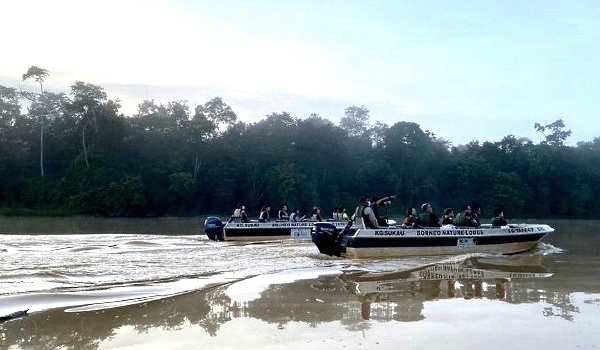
This is the Sukau area in the downstream of Kinabatangan, with thick forests and shrubs as well as wet plains crisscrossed by dense tributaries. This is also the place with the highest concentration of wildlife habitats in the whole country. Our boats cruised along the tributaries among the mangroves as we went on to explore the mysteries of the rainforest and inspect the many curious life forms here. But what is more important is that we have picked up some new knowledge about Mother Nature along the way.
Our eco guide told us the early bird catches the worm, so wild animals and birds start their day early in the morning, speeding their way in all directions and at times swooping down on a doomed prey. This is where only the fittest will survive, and feed on the weak.
The guide instructed the boatman to get near the riverbank as he explained: These are the footprints and fresh dung of Borneo elephants. It looks like we have good chances of meeting a couple of them today! Wow! The little one in our midst began to yell in excitement: Mom, there! The seasoned guide replied: A wild animal! What a precious sight! Just like life, we should feel contented instead of constantly pursuing the seemingly impossible!
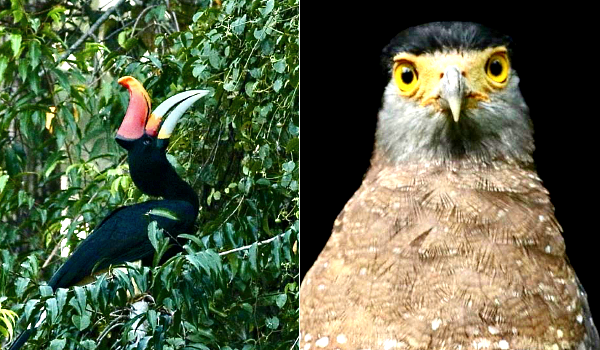
Listen, the rustling of tree leaves and branches out there! That's the natural orchard of this area! Borneo is home to eight different species of primates dwelling in the massive swathe of million years old mangrove forests here, and we were lucky to have a close peek of them. The most common among the primates here are the adorable long-tailed Keras as well as the coconut-plucking Beruks. We also chanced upon the extremely rare silver leaf monkeys and even a couple of wild orangutans! For your information, although apes are 96.4% identical to humans genetically, they don't swim like us!
What really shocked me was that the entire forest was filled with the long-nosed proboscis monkeys which most of us had never seen before. Did you know these proboscis monkeys live among the mangroves and sleep by hugging the tree trunks? Although they are "vegetarians" feeding on tree leaves and fruits, they don't like sweet stuff! Interestingly, these monkeys have two stomachs for food regurgitation, and therefore have huge bellies. They have a digestive system similar to that of the cows, swallowing the food and sending it to stomach B first, and regurgitating it when they get hungry later, before sending the chewed food to stomach A. Their long noses are symbols of virility. They also have very long tails and stiff genitals like red hot chillies! As I said, you need to venture into the jungle to learn about the ecosystem!
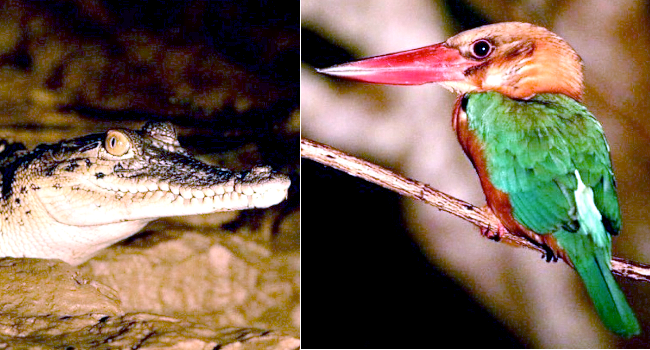
The guide added: proboscis monkeys practice polygamy and a male monkey may have plenty of "temporary wives". They have to be constantly alert of opponents trying to entice their female partners. These monkeys normally live in families of 10 to 20. Although they mostly live in peaceful coexistence, the man of the family nevertheless does not tolerate his women bearing the other monkeys' children. Like the African lions, they only want their own children and will get rid of those not from their bloodline. The kids are raised exclusively by the mother and when they become independent at the age of two, they will leave their homes and live with other single monkeys. Homosexuality does exist in some of them, I was told.
Between four to six each evening, these monkeys will start gathering in the shrubs along the riverbank to look for food or play among themselves. Sure enough all this fell into our close vision. May I add that the International Union for Conservation of Nature has put the proboscis monkeys in the red endangered animal list?
To be honest, I came to Kinabatangan to see orangutans but these proboscis monkeys have become the unexpected stars in our jungle adventure!

The 560km Kinabatangan River, the longest in Sabah and second longest in the country, has its headwaters in the mountains in the Sabah interiors, coursing eastwards before emptying into the Sulu Sea. The most common catch here is the juicy Ikan Patin and succulent Udang Galah. To the indigenous Orang Sungai living along the river, these fishes and prawns are their major source of income. The downriver lowlands are nevertheless marshy and unsuited for farming. The good news is, the virgin forest here is home to many wild animals. But sadly, much of the virgin forest here has been cut down and planted with oil palm which carries very attractive commercial values. As a result, the wild animals here such as the Malayan sun bears, orangutans and proboscis monkeys have been made homeless. It is a matter of time humans will suffer the consequences of our heartless destruction of the virgin forests and vulnerable ecosystem.
Back in Sandakan, the 45 of us were divided into two groups to pay a visit to Dr. Wong Siew Te of Bornean Sun Bear Conservation Center. Dr Wong has been named a CNN Hero for spending much of his life protecting the endangered Malayan sun bears. He gave us a detailed account of how he had salvaged the cubs from poaching and slaughtering, training them with loving care at the center before releasing them back to the forest.
We came across so many colorful things and people during this highly educational Kinabatangan trip and bore witness to the rich natural resources we have been so generously endowed with!
(Lee San is Founder and Group Executive Chairman of Apple Vacations. He has traveled to 132 countries, six continents, and enjoys sharing his travel stories and insights. He has also authored five books.)
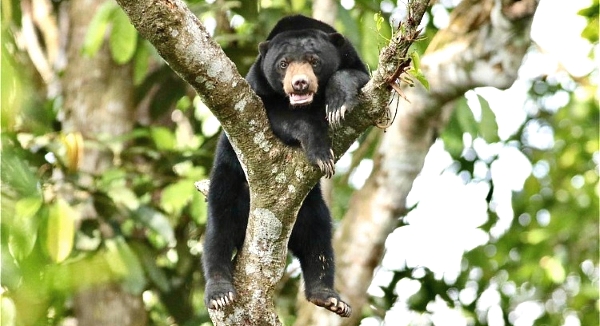
ADVERTISEMENT
ADVERTISEMENT


































